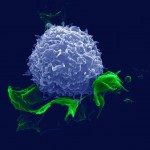Link to Pubmed [PMID] – 8790568
J. Viral Hepat. 1994;1(2):131-7
It is generally agreed that hepatitis B virus (HBV) replication is reduced by hepatitis delta virus infection (HDV) and augmented by human immunodeficiency virus (HIV) infection. However, the precise nature of the interactions between HBV, HDV and HIV is controversial. The aim of this study was to evaluate the impact of HIV infection on HBV and HDV replication, and on histological scores during delta virus superinfection in HDV-positive, chronic carriers of hepatitis B surface antigen (HBsAg). We studied 38 men and six women, 15 of whom were HIV-positive and all of whom had at least one marker of HDV infection. Serum hepatitis B e antigen (HBeAg), HBV DNA, HDV RNA, anti-delta antigen antibodies (anti-HD) IgM, anti-HD IgG and hepatitis delta antigen (HDAg) were tested for in the serum and liver, respectively; anti-hepatitis C virus (HCV) antibodies were detected using a second-generation recombinant immunoblot assay. Histological specimens were scored blindly according to Knodell’s classification for periportal and intralobular necrosis, portal inflammation and fibrosis. HBV DNA was detected more frequently in the HIV-positive patients than in those who were HIV-negative (25 vs 0%; P = 0.01), while markers of HDV replication (serum anti-HD IgM, serum HDV RNA and liver HDAg) were as frequent in the HIV-positive patients (69%, 40% and 50%, respectively) as in those who were HIV-negative (75%, 52% and 30%, respectively; P > 0.05). By contrast, 31% of the HIV-positive patients were serum HDAg-positive compared to only 6% of the HIV-negative patients (P = 0.001). HDV antigenaemia and anti-HD antibodies usually fluctuated in the HIV-positive patients during follow-up. The mean Knodell score was similar in the HIV-positive (11.5 +/- 3.2) and HIV-negative (10.7 +/- 2) subgroups, as was the mean semi-quantitative index of hepatic necrosis, inflammation and fibrosis. Our results provide evidence that in HDV-positive patients: (1) HIV infection counters the inhibitory effect of HDV superinfection on HBV replication; (2) serum anti-HD IgM. HDV RNA and liver HDAg are not more frequent in HIV-positive than in HIV-negative patients, suggesting that HIV infection has no effect on HDV replication (although the significance of the increased frequency of HD antigenaemia remains unclear); (3) the histological severity of liver disease is not influenced by HIV status.

